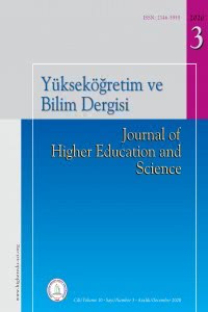Üniversite Öğrencilerinde Devamsızlık Davranışları: Nedenler ve Tutum Düzeyleri
Devamsızlık, Üniversite öğrencisi, Tutum, Eğilim
Absenteeism Behavior among University Students: Causes and Attitude Levels
Absenteeism, University student, Att itude, Tendency,
___
- Adıgüzel, A. & Karadaş. H. (2013). OrtaöğreƟ m öğrencilerinin okula ıli̇şkin tutumlarının devamsızlık ve okul başarıları arasındaki ıli̇şki. YYÜ EğiƟ m Fakültesi Dergisi (YYU Journal of EducaƟ on Faculty), 10(1), 49-66
- Alƨ nkurt, Y. (2008). Öğrenci devamsızlıklarının nedenleri ve devamsızlığın akademik başarıya olan etkisi. Dumlupınar Üniversitesi Sosyal Bilimler Dergisi, 20, 129-142.
- Anonim (1997). Cumhuriyet Üniversitesi Ön Lisans ve Lisans EğiƟ m ÖğreƟ m ve Sınav Yönetmeliği. TC Resmi Gazete. 21 Temmuz.
- Anonim (2013). Cumhuriyet Üniversitesi Ön Lisans Ve Lisans EğiƟ m-ÖğreƟ m Ve Sınav Yönetmeliği. TC Resmi Gazete. 11 Temmuz.
- AusƟ n, W.A. & Totaro, M.W. (2011). Gender diff erences in the eff ects of internet usage on high school absenteeism. Journal of Socio-Economics, 40(2), 192-198.
- Bener, A., Kamal, M., & Shanks, N.J. (2007). Impact of asthmaand air polluƟ on on school aƩ endance of primary school children: Are they at increased risk of school absenteeism? Journal of Asthma, 44, 249–252.
- Baxter, S.D., Royer, J.A., Hardin, J.W., Guinn, C.H., & Devlin, K.M. (2011). The relaƟ onship of school absenteeism with body mass index. Academic achievement And Socioeconomic Status Among Fourth-Grade Children. Journal of School Health, 81(7), 417-423.
- Chan, K. C., Shum, C., & Wright, D. J. (1997). Class aƩ endance and student performance in principles of fi nance. Financial PracƟ ce and EducaƟ on, 7, 58-65.
- HartneƩ , S. (2008) Does peer group idenƟ ty ıṅ fl uence absenteeism in high school students? 35-44. Retrieved from http://eds.b.ebscohost.com/eds/pdfviewer/pdfviewer?vid =13&sid=0f62af72-3924-4086-a061-ba32ca8cf8b4%40sessio nmgr113&hid=10709/03/2014 tarihinde alınƨ lanma.
- Kağıtçıbaşı, Ç. (2013). Günümüzde ınsan ve ̇ ınsanlar, sosyal ̇ psikolojiye giriş. İstanbul: Evrim Yayınları.
- Kadı, Z. (2000). Adana İli Merkezindeki İlköğreƟ m Okulu Öğrencilerinin Sürekli Devamsızlık Nedenleri. Yayınlanmamış Yüksek Lisans Tezi; İnönü Üniversitesi Sosyal Bilimler EnsƟ tüsü. İnönü Üniversitesi. Malatya.
- Kearney, C. A. & Silverman, W. K. (1990). A preliminary analysis of a funcƟ onal model of assessment and treatment for school refusal behavior. Behavior Modifi caƟ on, 1, 340-366.
- Kearney, C.A. & Bensaheb, A. (2006). School absenteeism and school refusal behavior: A review and suggesƟ ons for schoolbased health professionals. Journal of School Health, 76(1), 3-7.
- Kearney, C.A. (2008). School absenteeism and school refusal behavior in youth: A ontemporary review. Clinical Psychology Review, 28, 451-471.
- Lounsbury, J.W., Steel, R.P., Loveland, J.M., & Gibson, L.W. (2003). An invesƟ gaƟ on of personality traits in relaƟ on to adolescent school absenteeism. Journal of Youth and Adolescence, 33(5), 457–466.
- Morgan, C.T. (1991). Psikolojiye giriş (Çev. Hüsnü Arıcı). Ankara: HaceƩ epe Üniversitesi Yayınları.
- Nair, M. K. C. (2010). School absenteeism among children. Indian Pediatricts, 47(17), 921-922.
- Özkanal, Ü. & Arıkan, N. (2011). The relaƟ on between success and absenteeism at esogu english preparatory school. Journal of Language Teaching and Research, 2(1), 68-72.
- Pehlivan, Z. (2011). Absenteeism at state high schools and related school management policies in Turkey. Procedia Social and Behavioral Sciences, 15, 3121–3126.
- Piovesan, C., Antunes, J. L. F., Mendes, F.M., Guedes, R. S., & Ardenghi, T. M. (2012). Influence of children’s oral healthrelated quality of life on school performance and school absenteeism. Journal of Public Health DenƟ stry,72, 156–163.
- Reid, K. (2006). The causes. Views and traits of school absenteeism and truancy: An analyƟ cal review. Retrieved from hƩ p://www. redorbit.com/news/education/396422/the_causes_views_ and_traits_of_school_absenteeism_and_truancy/internet sitesinden 09/03/2014 tarihinde alınƨ lanmışƨ r.
- Robbins, S. (1994). Örgütsel davranışın temelleri (Çev: Sevgi Ayşe Öztürk). Eskişehir: Etam Basım Yayım.
- Roby, D. (2013). Teacher eƩ endence eff ects on student achievement: Research Study of on Ohio Schools, 34(132), 201-206.
- Taylı, A. (2008). Okulu bırakmanın önlenmesi ve önlemeye yönelik uygulamalar. Abant İzzet Baysal Üniversitesi EğiƟ m Fakültesi Dergisi, 8(1), 91-104.
- Yıldız, M. &Kula, K.Ş. (2011). Elazığ ılindeki ̇ ılkö̇ ğreƟ m ıkinci ̇ kademe öğrencilerinin devamsızlık sebeplerinin ıncelenmesi. ̇ Fırat Üniversitesi Fen Bilimleri Dergisi, 23(2), 133-140.
- ISSN: 2146-5959
- Yayın Aralığı: 3
- Başlangıç: 2011
- Yayıncı: Bülent Ecevit Üniversitesi (Önceden Zonguldak Karaelmas Üniversitesi)
Meslek Yüksekokullarındaki Mevcut Durum: Sorunlar ve Bazı Çözüm Önerileri
REHA METİN ALKAN, MENDERES SUİÇMEZ, MEHMET AYDINKAL, MENEKŞE ŞAHİN
Hemşirelik Öğrencilerinin Bağlanma Stillerinin Belirlenmesi
Mevcut İmkânlarla Seçkin Öğretim Üyesi, Yıldız Araştırmacı ve Lider Yetiştirme Projesi
Ömer KARAHAN, FAİKA ŞANAL KARAHAN
Pakistan'da Kuruluştan Günümüze Yükseköğretim Politikaları ve Uygulamaya Yansımaları
Tıpta Uzmanlık Tezi: Tartışılan Sürece Bir Araştırma Kapsamında Bakış
Mehmet Bilgin SAYDAM, uray ÖZGÜLNAR, Feyza DARENDELİLER
Yükseköğretimi ve Tıp Fakültelerini Yeniden Düşünme, Yarını Planlama
Amerika Birleşik Devletleri Eğitim Fakültelerinde Klinik Öğretim Üyeleri: Genel Bir Bakış
Üniversite Öğrencilerinde Devamsızlık Davranışları: Nedenler ve Tutum Düzeyleri
